Since my arrival in India two years ago, I have been engaging as much as I can with Indian museums. Like in many other parts of the world, museums in India are currently undergoing a massive much-needed reinvention. These are some of the challenges that museums professionals here are working on:
- Limited access to quality conservation, leaving too many artifacts to decay and degrade
- Government funding, which obstructs revenue-generating models for museum management
- Poor displays with incomplete and uninteresting interpretation
- Colonial legacies, including the ongoing struggle to reacquire artifacts stolen by European collectors
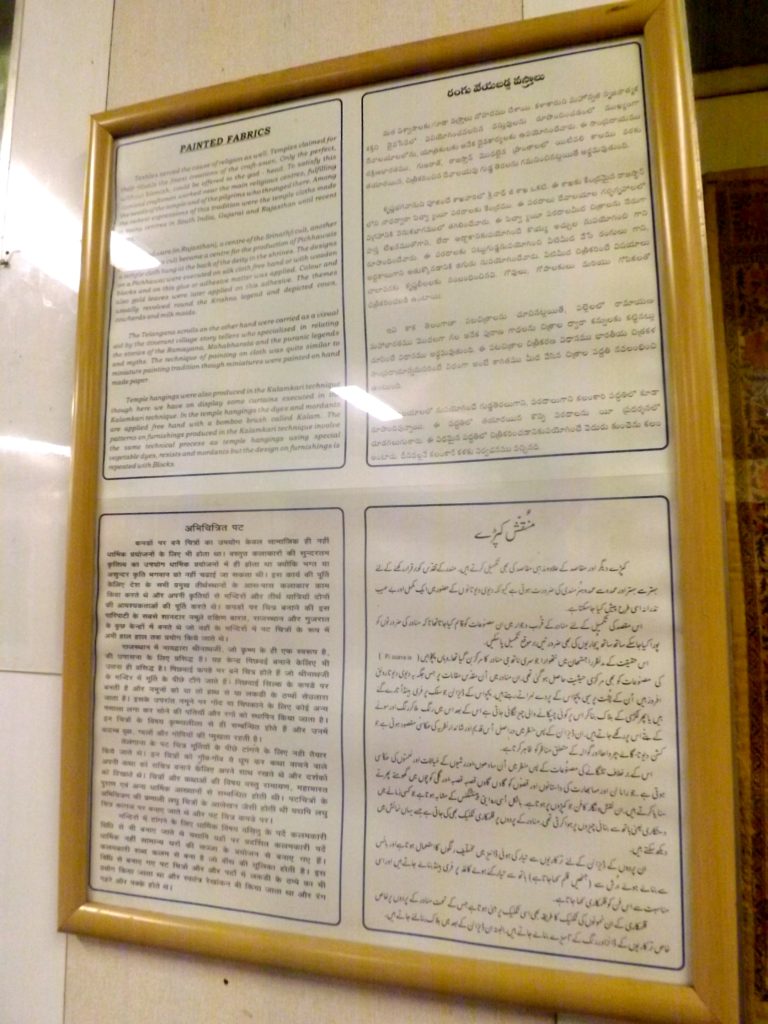
A better design and placement of the multi-lingual text panels would increase audience interest and engagement. Photo by author (Sept. 2016)
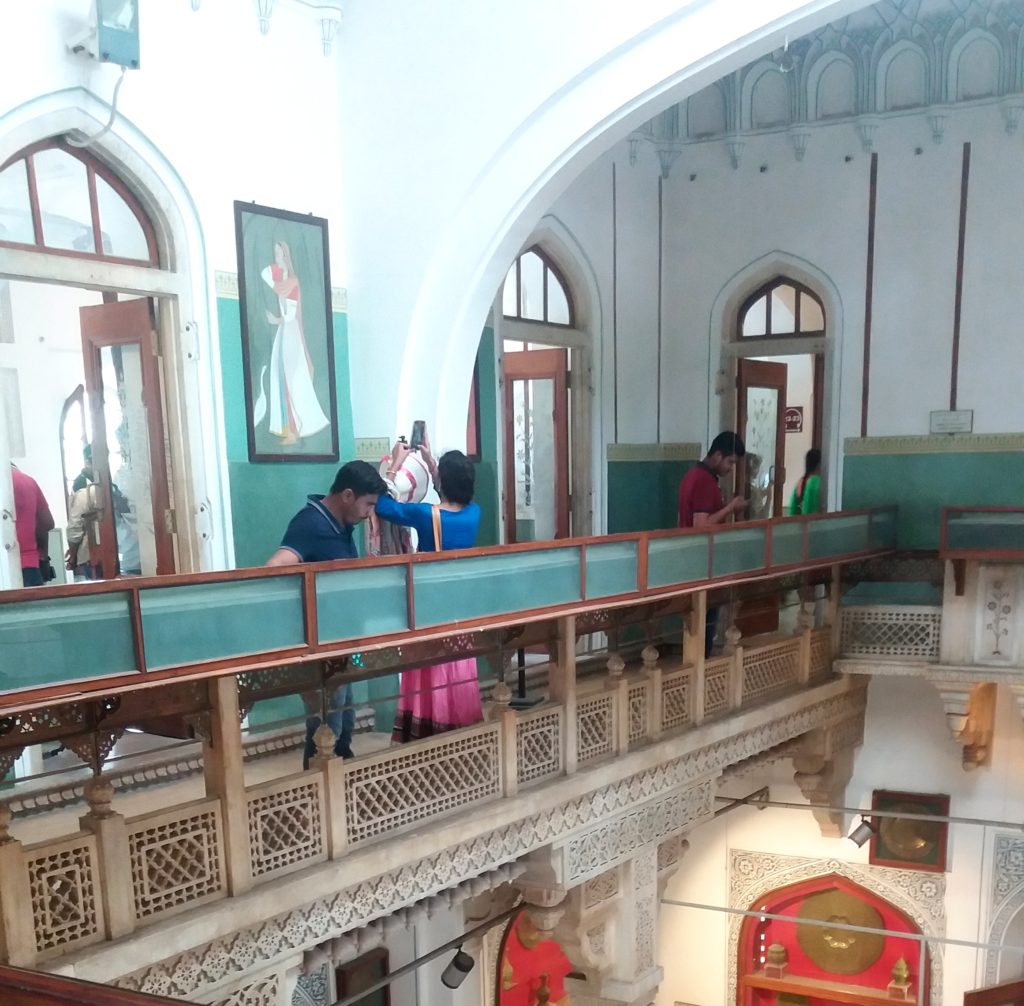
Housing museums in colonial-era buildings often mean dealing with architecture that may not be ideal for museum displays. (Sept 2016)
Coming from the United States, I can see that these as challenges in many Indian museums. I am hopeful, however, as I continue to learn about more up-and-coming organizations and private museums which are innovating solutions across the country.
A very basic indication is how different the conversations about museum issues in India are from those in the United States. While Indian museum professionals are largely dealing with institutional challenges, U.S. museum professionals are tackling people-centric issues like:
- Lack of diversity among museum employees
- Unequal representation of women in museum leadership
In the United States, diversity is most often associated with race. The Mellon Foundation is a philanthropic organization with commitments to diversity in the humanities, and in 2015 it undertook a landmark survey to measure diversity in art museums across the United States. At the time, 62% of the total U.S. population identified as White (Caucasian). The people who worked as curators, conservators, educators, and executive leaders in art museums, however, were disproportionately 84% White.
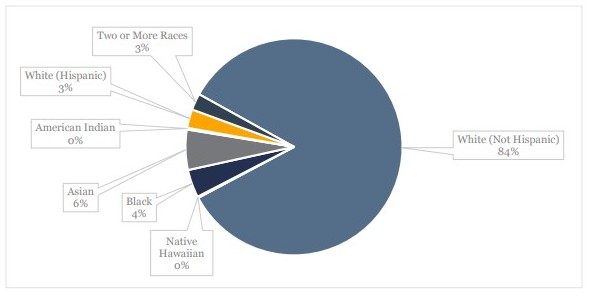
Race and Ethnicity of U.S. Art Museum Curators, Conservators, Educators and Leadership. Source: https://mellon.org/media/filer_public/ba/99/ba99e53a-48d5-4038-80e1-66f9ba1c020e/awmf_museum_diversity_report_aamd_7-28-15.pdf
The professional community knows that this white-race dominance of U.S. museums is problematic for at least two pressing reasons:
- Museum employees do not represent the increasingly diverse communities that museums serve. Thus, they often lack a thorough understanding of the communities’ socio-cultural needs and interests.
- Curatorial decisions are primarily informed by people who come from similar (white) backgrounds and (often, middle to upper-class) experiences. This limits broader understanding of objects and media in a museum’s collections.
The importance of this discussion to the U.S. museum industry is highlighted by the American Alliance of Museums’ working group on Diversity, Equity, Accessibility, and Inclusion. The group was convened in 2017 after the Alliance’s annual meeting, and the results of its work were published at the 2018 meeting in May. Other responses include the founding of Museum Hue in 2015, an organization committed to supporting the representation of people of colour in museums; and the #DecolonizeThisPlace movement in response to the Brooklyn museum’s hiring of a white woman as curator of African Art.
Looking at the issue of women in museum leadership, the same Mellon Foundation survey found that U.S. museums overall employ more women than men.
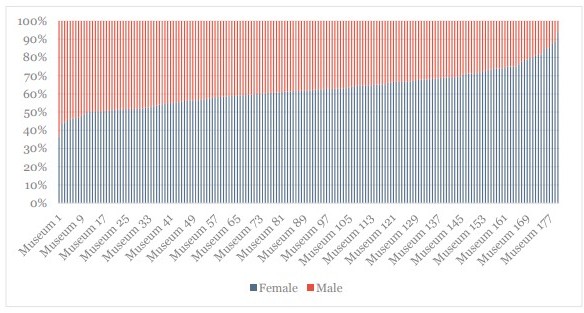
The proportion of Female and Male Employees at U.S. Art Museums. Source: https://mellon.org/media/filer_public/ba/99/ba99e53a-48d5-4038-80e1-66f9ba1c020e/awmf_museum_diversity_report_aamd_7-28-15.pdf
In a closer look at museum leadership, however, a 2016 survey conducted by the Association of Art Museum Directors had a different story to tell. Significantly, the larger a museum’s budget is, the less likely it is to be managed by a woman. The proportion of female to male museum directors drops below 1:1 when the museum budget is more than 15 million USD. It drops down to 1:2 over 20 million USD, and again to nearly 1:3 over 30 million USD.
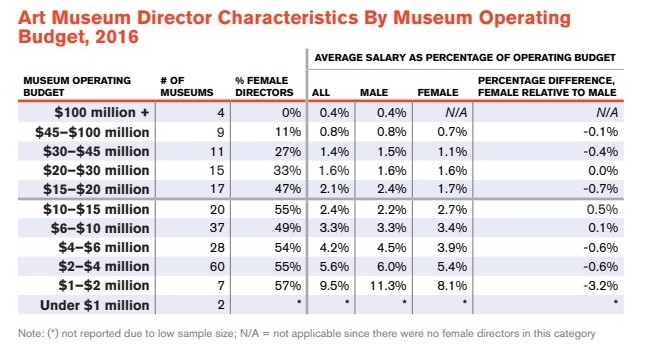
Source: https://aamd.org/sites/default/files/document/AAMD%20NCAR%20Gender%20Gap%202017.pdf
Additionally, when women are hired into positions as museum directors, they are typically paid less than men in the same role. Depending on the type of museum, the Association of Art Museum Directors found that women tend to earn between 91% and 69% of what men earn as museum directors.
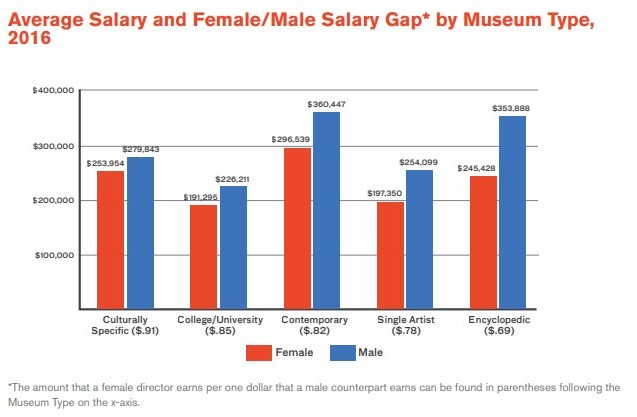
Source: https://aamd.org/sites/default/files/document/AAMD%20NCAR%20Gender%20Gap%202017.pdf
Seeing more women in high-level leadership roles is crucial to achieving gender equality in the U.S. museum sector. Two of the most prominent professionals supporting women in museum leadership are Anne Ackerson and Joan Baldwin. Their activism includes speaking at this year’s AAM annual meeting on the topic of Gender and the Museum Workforce, co-authoring the 2017 book Women in the Museum, co-founding the Gender Equity in Museums Movement, and conducting a recent survey on gender equality and sexual harassment in the museums’ workplace.
In India, as yet I have not come across much discussion about these issues of diversity and representation. Of course, the demographic landscapes and work cultures of India and the United States are completely different. I do think, however, that these people-centric issues also form an important part of the institutional challenges in museums.
A brief glance at gender equality in museum leadership in India does not reveal much better results than the situation in the United States. There does seem to be a significant difference, however, between the leadership of private Indian museums versus government ones. Among four of the top private museums, two were founded or co-founded by women: the Kiran Nadar Museum of Art and the Devi Art Foundation (co-founded by Lekha Poddar and her son).
Private museums are just a small sector – about 10% – of India’s museum landscape, though. When it comes to government museums, women are notably less visible in directorship. While the current ASI Director-General is a lady, the position of Minister of Culture is held by a gentleman. Moreover, the seven government museums that are run by the Ministry are also all headed by male directors. Considering state-governed museums in South India alone, two Directors of Museums are female (in Telangana and Tamil Nadu) while four are male (in Karnataka, Andhra Pradesh, Pondicherry, and Kerala).
The blended model of a public-private partnership museum in India also shows mixed results for gender equality in museum leadership. Of three of the most prominent PPP museums, the Bhau Daji Lad Mumbai City Museum is currently under the female directorship of Dr Tasneem Zakaria Mehta. CSMVS, on the other hand, and the new Bihar Museum is under the direction of male leadership.
When it comes to diversity in India, we could look beyond categories of race to others such as language, religion, geographic region, class, and caste. In a quick online search, however, there appear to be no relevant results discussing diversity within the workforce of Indian museums. Articles that talk about diversity across all work sectors, in general, tend to focus on gender alone and bringing more women into the workplace. When it comes to museums specifically, especially national ones that cover encyclopedic topics from across the country, perhaps employing professionals from different backgrounds would be a great benefit as well.
The question is one of who has access to the education needed to work in a museum in India. Such access is likely to become more relevant as Indian museums continue to move towards privatized models and as more museum professionals emphasize specialized higher education in Museology. Are museum professionals disproportionately from a particular geographic region? Do they speak or read the indigenous languages of the states they work in? How does their religious practice or economic status introduce potential biases in museum practice? These are some questions that I am still looking for answers for.
Just like in the U.S. however, museums in India also risk becoming elitist if they are primarily run by people who come from largely similar backgrounds. In this historic stage of revolutionizing and revitalizing Indian museums, fundamental institutional issues can also be seen as intersecting with other people-centric challenges. By bringing both sectors of debates into focus, Indian museum professionals can innovate concurrent solutions. Similarly, when the Indian museums’ workforce and leadership open up decision making to more women and diverse professionals, there can be greater opportunity for more electrifying transformation across the board.

Sarah Lamade is a former Fulbright fellow, researcher and freelance writer based out of Pondicherry. Her background is in Anthropology and Museum Studies and she is working towards a career as a cultural consultant. She aims to support museums as inclusive and engaging educational spaces for dialogues which cut across boundaries.
ReReeti works with museums, galleries and heritage sites across India to plan strategies, design systems and implement programmes to increase audience engagement and institutional/ company visibility. Email us at info@rereeti.org for a free consultation or to collaborate on an upcoming exhibition.








Recent Comments